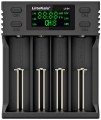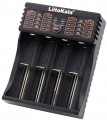Size
The battery sizes that the charger is compatible with. In this case, the adapters supplied in the kit (see below) are not taken into account in this paragraph, we are talking only about the memory as such.
The standard dimensions describes the shape, dimensions, connector design and operating voltage of the battery; thus, it is one of the most important parameters for determining compatibility with a particular charger.
The most popular sizes for which modern “chargers” are made can be divided into 1.5-volt (marked in Latin letters
AA,
AAA,
C,
D) and 3.7-volt (have digital markings
14500,
17500,
18650,
22650,
26650, etc. .P.). More about them:
— AAAA. The smallest version of the "finger" dimensions: batteries of the same cylindrical shape as the well-known AA and AAA, but with a size of only about 8 mm and a length of about 43 mm. Similar in application to AAA, but very poorly distributed.
— AAA. Size, colloquially known as "mini finger" or "little finger batteries": cylindrical batteries with a size of 10.5 mm and a length of 44.5 mm. They are mainly used in miniature devices for which there are not enough “tablet” bat
...teries, and larger elements are too bulky.
— AA. Classic "finger" batteries with a size of 14 mm and a length of 50 mm, one of the most popular modern standard sizes (if not the most popular). They are used in a wide variety of types and price categories of devices, including even external battery packs for SLR cameras.
- C. Batteries in the form of a characteristic "barrel". They are similar in height to finger-type AAs, but almost twice as thick - 50 mm and 26 mm, respectively - due to which they have a higher capacity.
- D. The largest dimensions of consumer grade 1.5V batteries, 34mm in size and 61mm in length. It is mainly used in high-power flashlights and devices with high energy consumption.
3.7-V batteries are indicated by a five-digit number. In it, the first two digits indicate the size (in millimeters), the remaining three indicate the length (in tenths of a millimeter). For example, the popular dimensions 18650 corresponds to a battery with a size of 18 mm and a length of 65.0 mm. It is worth noting here that there are 3.7-volt cells that are the same dimensions as the 1.5-volt ones described above (for example, the 14500 dimensions is similar to AA finger-type), but both types are not interchangeable due to the difference in voltage.
A separate category is 9-volt R22 batteries, also known as PP3: these are rectangular elements in which a pair of contacts is located on one of the ends.Operation indicator
The method of indicating work, in other words, the type of notifications provided for in the design of the charger.
— LED. LED indicators can give messages by turning on and off, blinking at a certain frequency, and changing colours. They are cheaper than displays (see below) and are more visible from a distance, but less informative and more limited in their capabilities.
—
Display. Chargers tend to use simple LCD displays. However, even such screens are much more informative and visual than LED indicators. A wide variety of information can be displayed on the display, and in a form that is convenient for perception: the user does not need to remember what this or that light means, he immediately sees a specific message, for example, “Charging is over”. However and this convenience is much more expensive.
Independent charge channels
The number of independent charging channels provided in the design of the charger.
If the voltage, charging current and other parameters in this model are regulated on all battery slots at the same time, this means that the device has only one channel. The presence of several charging channels allows you to set your own operating parameters on separate slots and, accordingly, simultaneously charge different types of batteries in one device. In this case, the channel can cover both one slot and several: for example, many models for 4 batteries have only 2 channels (one for every 2 slots).
The abundance of channels expands the capabilities of the "charger" and will be especially useful in cases where you often have to charge different types of batteries; on the other hand, it significantly affects the cost of the device.
Charge current (all channels)
The highest current provided by a multi-channel charger (see "Independent channels") at full load, with all slots (and, accordingly, channels) operating. In fact, a guaranteed maximum current provided by a multi-channel charger, regardless of the number of channels involved.
For the total charge current, see “Maximum charge current. Here we note that the full load is a rather complex mode in which the current strength can decrease. Therefore, this parameter is specified separately.
Number of settings
The number of separate charge current settings (see above) provided in the design of the charger. For example, a device with 4 settings may provide options for 200, 400, 800 and 1000 mAh. In general, the larger this number, the more accurately you can choose the charging current for a particular situation.
Capacity recovery
The
capacity recovery function will be useful for batteries with memory effect - this time tech whose capacity has already declined. In this mode, the charger discharges and charges the battery several times in a special way, which eliminates the memory effect and restores the battery, if not to the original, then at least to a capacity close to this value.
USB output charging gadgets
The ability to use the charger to charge portable electronics - smartphones, tablets, players, etc. As a rule, for this, a
USB port is provided in the design, for connection to which an appropriate cable is required; in fact, you can charge from such a device not only mobile gadgets, but also any equipment that can be powered from USB. True, it is worth noting that some manufacturers do not recommend using third-party devices for their equipment if they are not officially approved.
Overheat protection
A function that prevents critical heating of the batteries installed in the charger. Excessive heat on its own is usually a sign of a problem or abnormal operation, and an increase in temperature can cause a fire or even an explosion of the battery.
Overheating protection systems usually use special sensors that monitor the state of the battery and turn off the heating if necessary.

